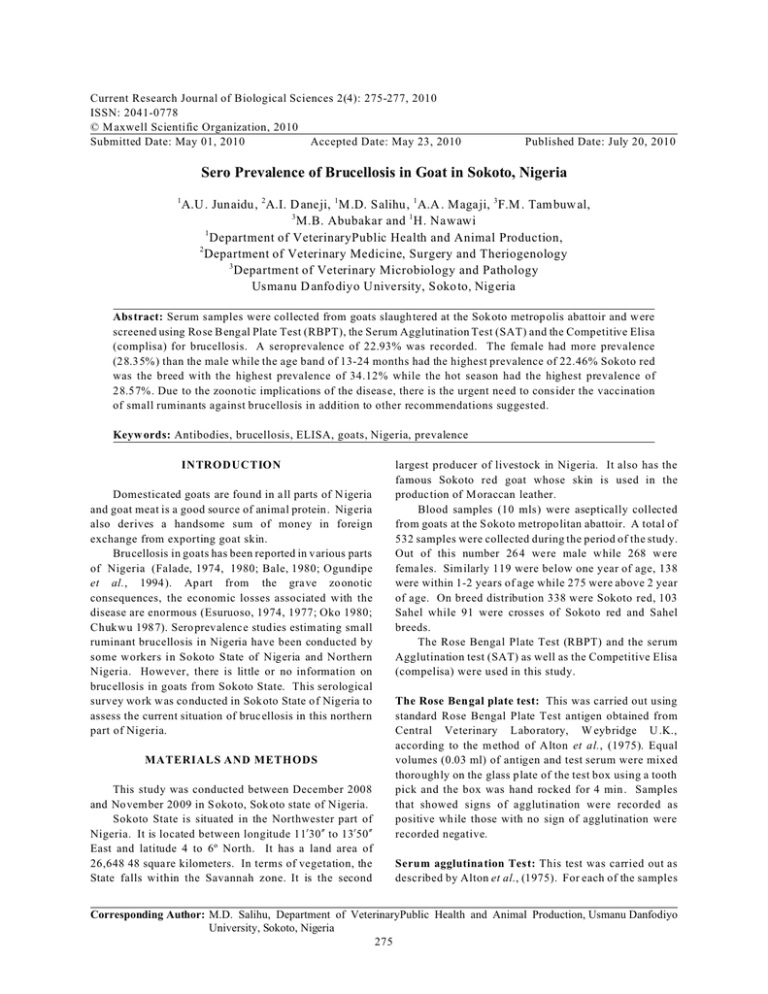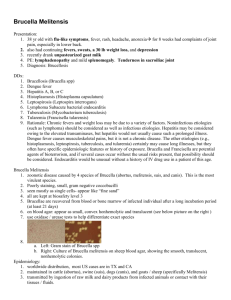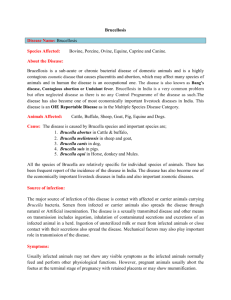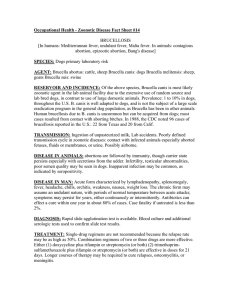Current Research Journal of Biological Sciences 2(4): 275-277, 2010 ISSN: 2041-0778
advertisement

Current Research Journal of Biological Sciences 2(4): 275-277, 2010 ISSN: 2041-0778 © M axwell Scientific Organization, 2010 Submitted Date: May 01, 2010 Accepted Date: May 23, 2010 Published Date: July 20, 2010 Sero Prevalence of Brucellosis in Goat in Sokoto, Nigeria 1 A.U . Junaidu, 2 A.I. D aneji, 1 M.D. Salihu, 1 A.A . Magaji, 3 F.M . Tam buw al, 3 M.B. Abubakar and 1 H. Nawawi 1 Department of VeterinaryPublic Health and Animal Production, 2 Department of Veterinary Medicine, Surgery and Theriogenology 3 Department of Veterinary Microbiology and Pathology Usmanu D anfodiyo University, Soko to , Nigeria Abstract: Serum samples were collected from goats slaugh tered at the Sokoto metropolis abattoir and w ere screened using Rose Bengal Plate Test (RBPT), the Serum Agglutination Test (SAT) and the Competitive Elisa (complisa) for brucellosis. A seroprevalence of 22.93% was recorded. The female had more prevalence (28.35%) than the male while the age band of 13-24 months had the highest prevalence of 22.46% Sokoto red was the breed with the highest prevalence of 34.12% while the hot season had the highest prevalence of 28.57%. Due to the zoono tic implications of the disease, there is the urgent need to consider the vaccination of small ruminants against brucellosis in addition to other recommendations suggested. Keyw ords: Antibodies, brucellosis, ELISA, goats, Nigeria, prevalence INTRODUCTION Domesticated goats are found in all parts of Nigeria and goat meat is a good source of animal protein. Nigeria also derives a handsome sum of money in foreign exchange from exporting goat skin. Brucellosis in goats has been reported in various parts of Nigeria (Falade, 1974, 1980; Bale, 1980; Ogundipe et al., 1994 ). Apart from the gra ve zo onotic consequences, the economic losses associated with the disease are enormous (Esuruoso, 1974, 1977; Oko 1980; Chukwu 1987). Sero prevalence studies estim ating small ruminant brucellosis in Nigeria have been conducted by some workers in Sokoto State of Nigeria and Northern Nigeria. However, there is little or no information on brucellosis in goats from Sokoto State. This serological survey work was conducted in Sokoto State of Nigeria to assess the current situation of bruc ellosis in this northern part of Nigeria. MATERIALS AND METHODS This study was conducted between December 2008 and Novem ber 20 09 in S okoto, Sok oto state of Nigeria. Sokoto State is situated in the Northwester part of Nigeria. It is located between longitude 11!30" to 13!50" East and latitude 4 to 6º North. It has a land area of 26,648 48 squa re kilometers. In terms of vegetation, the State falls within the Savannah zone. It is the second largest producer of livestock in Nigeria. It also has the famous Sokoto red goat whose skin is used in the production of M oraccan leather. Blood samples (10 mls) were aseptically collected from goats at the Sokoto metropolitan abattoir. A total of 532 samples were collected during the period of the study. Out of this number 26 4 were male w hile 268 w ere fema les. Sim ilarly 119 were below one year of age, 138 were within 1-2 years of age while 275 were above 2 year of age. On breed distribution 338 were Sokoto red, 103 Sahel while 91 were crosses of Sokoto red and Sahel breeds. The Rose Bengal Plate Test (RBPT) and the serum Agglutination test (SAT) as well as the Competitive Elisa (compelisa) were used in this study. The Rose Bengal plate test: This was carried out using standard Rose Bengal Plate Test antigen obtained from Central Veterinary Laboratory, W eybridge U .K., according to the m ethod of Alton et al., (1975). Equal volumes (0.03 ml) of antigen and test serum were mixed thoroughly on the glass plate of the test box using a tooth pick and the box was hand rocked for 4 min . Samples that showed signs of agglutination were recorded as positive while those with no sign of agglutination were recorded negative. Serum agglutination Test: This test was carried out as described by Alton et al., (1975). For each of the samples Corresponding Author: M.D. Salihu, Department of VeterinaryPublic Health and Animal Production, Usmanu Danfodiyo University, Sokoto, Nigeria 275 Curr. Res. J. Biol. Sci., 2(4): 275-277, 2010 Table 1a: Sex Distribution of brucella infection in goats (Brucella abortus) Sex Total No. RBPT SAT M ale 264 2 7 (4 2.8 1% ) 2 9 (4 5.3 1% ) Fem ale 268 3 7 (5 7.8 % ) 3 4 (5 3.1 2% ) Total 532 64 63 SA T, Titire 1:40 = 7 1:80 = 12 1:160 = 10 1:40 = 9 1:80 = 8 1:160 = 7 Com pelisa 2 7 (4 2.1 8% ) 3 7 (5 7.8 % ) 64 Table 1b: Se x Distribution of brucella infection in goats (Bru cella me litensis ) Sex Total No. RBPT SAT M ale 264 2 7 (4 2.8 1% ) 2 9 (4 5.3 1% ) Fem ale 268 3 7 (5 7.8 % ) 3 4 (5 3.1 2% ) Total 532 64 63 SA T, Titire 1:40 = 7 1:80 = 12 1:160 = 10 1:40 = 9 1:80 = 8 1:160 = 7 Com pelisa 2 7 (4 2.1 8% ) 3 7 (5 7.8 % ) 64 Table 2a: A ge Distribution of brucella infection in goats (Brucella abortus) Age (m onths) Total No. RBPT 0-12 119 1 7 (1 4.2 8% ) 13-24 138 1 8 (1 3.0 4% ) Above 24 2754 4 9 (1 7.8 1% ) Total 532 SAT 1 7 (1 4.2 8% ) 1 8 (1 3.0 4% ) 2 9 (1 0.8 4% ) Com pelisa 1 7 (1 4.2 8% ) 1 8 (1 3.0 4% ) 4 9 (1 7.8 1% ) Table 2b: A ge Distribution of brucella infection in goats (Bru cella me litensis ) Age (m onths) Total number RBPT 0-12 119 2 5 (2 1% ) 13-24 138 1 3 (9 .4 2% ) Above 24 275 2 0 (7 .2 7% ) Total 532 58 SAT 2 2 (1 8.4 5% ) 9 (6 .5 2% ) 2 7 (9 .8 1% ) 58 Com pelisa 2 5 (2 1% ) 1 3 (9 .4 2% ) 2 0 (7 .2 7% ) 58 Table 3: Breed Distribution of Brucella infection in goats (Brucella abortus) Age(m onths) TotalNumber RBPT Sokoto Red 338 4 3 (1 2.7 2% ) Sah el 103 1 6 (1 5.5 % ) Cross 91 5 (5 .4 9% ) Total 532 58 SAT 4 0 (1 1.8 3% ) 1 2 (1 1.6 5% ) 11 (12.08) 58 Com pelisa 4 3 (1 2.7 2% ) 1 6 (1 5.5 0% ) 5 (5 .4 9% ) 58 that was positive in the RBPT two fold dilution of test sera from 1:10 (0.05 ml serum mixed with 0.45 ml phenolized saline) to 1:1280 was made. To each 0.5ml tube of phenolized saline serum mixture was added an equal volum e (0.5 m ) of the diluted (1:10) antigen resulting in a double (two-fold) dilution. The tubes containing the antigen-serum mixture were covered, shaken and incubated at 37ºC for 24 h. A positive reaction was one in which the serum-antigen mixture was clear with precipitate at the bottom not disru pted b y gen tle agitation. While a negative reaction is one in which the serum antigen mixture was turbid and gentle shaking revealed no precipitate at the bottom (Anonymous, 1981; Brisibe et al., 1993). Any serum with agglutination at a dilution of 1:40 (titre of 40) 50 international units) (Alton et al., 1975) and above was recorded as positive sample. were reconstituted as directed by the manufacturers. These included diluting buffer, washing solution, stopping solution, conjugate and control sera. The test procedure was carried out as per the man ufactu rer’s protocol. RESULTS Out of the 1,327 slaughtered goats during the period of study, 532 goats were screened, out of the 532 screened samples all together a total of 122 samples were positive for brucella (Ab ortus and m elitensis). 64(12.03% ) were positive for Brucella abortus while 58 samples (10.90%) were positive for Brucella m elitensis. Results of the SAT indicated that 29 samples had a titre of 1:160, 21 samples had a titre of 1:80 while 13 sample had a titre of 1:40. Table for the titres indicating B. abortus and B. m elitensis. On sex distribution, 46 male samples (17.92%) out of 264 samples screene d were po sitive w hile 76 (28.35%) fema le samples were positive out of the 268 screened. There was a sign ificant association between bru cella infection and se x (Table 1a, b). Com petitive elisa: (com pelisa). The competitive E lisa kit was obtained from Veterinary Laboratory Agency, W eybridge, United K ingdom . The reagents in the kit 276 Curr. Res. J. Biol. Sci., 2(4): 275-277, 2010 Ta ble 4a : Se aso n D istrib utio n Season Dry Hot Wet Total o f B ruc ella infe ctio n in go ats. ( Brucella abortus) Total number RBPT 211 2 4 (1 1.3 7% ) 126 1 4 (1 1.1 1% ) 195 2 6 (1 3.3 5% ) 532 64 SAT 2 4 (1 1.3 7% ) 1 4 (1 1.1 1% ) 2 6 (1 3.3 5% ) 64 Com pelisa 2 4 (1 1.3 7% ) 1 4 (1 1.1 1% ) 2 6 (1 3.3 5% ) 64 Ta ble 4b : Se aso n D istrib utio n Season Dry Hot Wet Total o f B ruc ella infe ctio n in go ats. ( Bru cella me litensis ) Total number RBPT 211 2 1 (9 .9 5% ) 126 1 5 (1 1.9 0% ) 195 2 2 (1 1.2 9% ) 532 58 SAT 2 1 (9 .9 5% ) 1 5 (1 1.9 0% ) 2 2 (1 1.2 9% ) 58 Com pelisa 2 1 (9 .9 5% ) 1 5 (1 1.9 0% ) 2 2 (1 1.2 9% ) 58 On age, 42 (21.10%) out of 119 screened samples were positive in the age band of 0-12 months. In the age band of 13-2 4 mo nths 31 (22.46% ) out of 138-screened samples were positive while 49 (17.81% ) out of 275 samples were positive in the age band of goats above 24 months of age. The re was no association between bruce lla infection and age (Table 2a, b). On breed distribution, Sokoto red recorded the highest prevalence with 86 positive (34.12%) out of 338 samples. This w as followed by Sahel with 26 positive samples (25.24 %) o ut of 103 screened. Crossbreed recorded 10 positive (10.98%) out of 91 screened samples. There was no association between b rucella infection and b reed (Tab le 3). On seasonal variation, samples screened during hot season recorded the highest prevalence of 28.57% with 34 out of 126 screened samples testing po sitive, in the wet season a prevalence of 24.61% was recorded while in the dry season a prevalence of 21.32% was observed. There was no association between brucella infection and season (Table 4a, b). REFERENCES Alton, G .G ., L.M . Jones and D .E. Pietz, 1975. L aboratory T echniques in Bru cellosis , W orld H ealth Organisation monograph series No. 454, Geneva. Anonymous, 1981. Procedure for incubating observing and reading the tube agglutination test (1981) NADL Diagnostic R ea ge nts M anual No. 65D. US Department of Agriculture, Ames, Iowa. Bale, J.O., 1980. Serological and bacteriological studies of ovine and caprine bruce llosis in Northern Nigeria. M.Sc. Thesis, Ahmadu Bello University, Zaria. Brisibe, F., D.R. Nawathe and C.J. Bot, 1993. Serological preva lence of Bru cellosis in sheep, G oats and hum an be ings in Maidug uri metropolis. Trop. Vet., 11: 27-33. Chukwu, C.C., 1987. Stydies on seroprevalence of bovine brucellosis. Zariya Vet., 1: 251-252. Esuruoso, G.O., 1974. Bovine brucellosis in Nigeria. Vet. Record., 95: 54-58. Esuruoso, G.O ., 1977 . Con trol of Brucellosis in Nigeria. Paper presented at the 2nd International symposium on Veterinary Epidemiology and Econom ic canberva, Australia. Falade, S., 1974. Brucella agglutinating antibodies in the sera of persons dwelling in Ibadan and the surrounding districts. J. N igerian Vet. Med. Assoc., 3: 21-24. Falade, S., 1980. A comparison of three se rological tests in the diagnosis of C aprine bruce llosis. Res. Vet. Sci., 24: 376-377. Keppie, J.W., A.E. Will and H. Smith, 1965. The ro le of erythritol in the tissue localization of the brucella. Br. J. Exp. Pathol., 46: 104-108. Ogundipe, G.A.T., H.N. Hwaichi and F.O. Ayanwale, 1994. A serological survey for the prevalence of brucella antibodies in slaughter goats in Ibadan, Nigeria. Bull. Anim. Health Prod. Africa, 42: 14-118. Oko, A.E .J., 1980. Abortion from b rucellosis in sheep in Kano, Nigeria. Trop. Anim. Health Prod., 11: 213-214. DISCUSSION The prevalence of Brucella abortus in goats obtained in this study may be attributed to the grazing habit in this part of the country where cattle graze with sheep and goats and are housed together. This close contact may likely aid in the transmission of Brucella abortus. The detection of higher antibod y titres in does than in bucks suggests that female animals are generally m ore susceptible to brucella infection than the males (Keppie et al., 1965). The econ omic loss resulting from bo vine b rucellosis in Nigeria as at 1979 w as put at $223.2 m illion (Esuruoso, 1977). With the prevale nce o f bruce llosis in goats and other small ruminants, the high economic loss and public health implications could be enorm ous. T his therefore calls for he introduction of mass vaccination for small ruminants. Large-scale sero monitoring exercise of ruminants and human beings at risk should also be done to asses the level of infection and diseases in both animals and humans in Nigeria. 277







